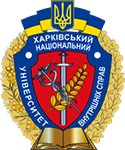Objects of forensic documentary science
DOI:
https://doi.org/10.32631/v.2023.2.23Keywords:
document science, document, forensic examination of a document, electronic document, digital technologies, information storage medium.Abstract
The article is devoted to the scientific analysis of the transformation of the “document” concept as an object of forensic research and to the identification of the main directions of development of forensic documentary science. The methodological basis of the study is the dialectical, formal-logical, formal-legal approaches, and a number of general scientific methods (historical, functional, praxeological). The systematic approach has ensured the comprehensive nature of the study and the unification of its results with a general theoretical conclusion. The scientific novelty lies in the establishment of promising areas for the development of an innovative methodology for conducting forensic document examination in the context of the use of special technical means and the methodology for the use of modern software products.
With the development of digital technologies, forensic science, in particular documentary science, has faced a significant number of new objects that require different approaches to research methods and tools. The transformation of the document as an object of forensic document science has significantly increased the demand for innovative technologies for research, making it necessary to integrate science and digital technologies in the investigation of crimes. The increase in the number of offences requiring the examination of electronic data storage devices poses new challenges for forensic experts, requiring modern means of recording and comparing them with standards. Forensic document research has acquired a different meaning and faced new challenges. With the development of digital technologies, forensic documentary requires the improvement of methods and means of researching information storage media.
The transformation of the “document” concept has led to its definition as a carrier of information regardless of the way it is recorded. In parallel with the study of the classical written paper document, forensic science has in a short time mastered the methods and means of studying plastic cards, digital storage devices and electronic money. Forensic science defines a document as an object such as video documents, photo documents, film documents, etc. The current level of research is not determined by the traditional comparison with a reference sample, and sometimes such a sample does not exist at all. The research of a document cannot be considered complete without determining the originality of the information it contains, without comparing this information with other possible storage media of the same information.
Downloads
References
Biriukov V.V., Kovalenko V.V., Biriukova T.P. and Kovalov K.M., 2007. Forensic documentary science [Kryminalistychne dokumentoznavstvo]. Kyiv: PALYVODA A.V.
Krushelnytska O.V., 2006. Methodology and organization of scientific research [Metodolohiia ta orhanizatsiia naukovykh doslidzhen]. Kyiv: Kondor.
Korzh I.F., 2017. Object and subject of scientific research in the information field [Obiekt i predmet naukovoho doslidzhennia v informatsiinii sferi]. Ìnformacìâ ì pravo – Information and Law, No. 3, pp. 22-29. https://doi.org/10.37750/2616-6798.2017.3(22).273041.
Shvetsova-Vodka N.M., 1998. Document typology [Typolohiia dokumenta]. Kyiv: Knyzhkova palata Ukrainy.
Shepitko V.Yu., Zhuravel V.A., Konovalova V.O. et al., 2019. Forensics [Kryminalistyka]: in 2 vols. Vol. 1. Kharkiv: Pravo. (Ed.: Shepitko V.Yu.).
Lantsedova Yu.O., 2017. Forensics [Kryminalistyka]. Kyiv: NAU.
Khan R.A. and Lone S. A., 2021. A comprehensive study of document security system,open issues and challenges. Multimedia Tools and Applications, No. 80. https://doi.org/10.1007/s11042-020-10061-x.
Sezonov V.S., Fialka M.I., Poltavski M.E., Prokopenko N.M. and Fomenko M.V., 2022. Forensic Examination of Electronic Documents. Law, State and Telecommunications Review, Vol. 14, No. 2, рp. 81-93. https://doi.org/10.26512/lstr.v14i2.40965.
Shvedova O.V., 2006. Comprehensive forensic investigation of documents made with the help of computer technologies [Kompleksne kryminalistychne doslidzhennia dokumentiv, vykonanykh za dopomohoiu kompiuternykh tekhnolohii]. Ph.D. dissertation. Kyiv National University of Internal Affairs.
Kerniakevych-Tanasiichuk Yu.V., Sezonov V.S., Nychytailo I.M., Savchuk M.A. and Tsareva I.V., 2021. Problems of forensic identification of handwriting in forensic examination [Problemy kryminalistychnoi identyfikatsii pocherku u sudovii ekspertyzi]. Vìsnik Nacìonalʹnoï akademìï pravovih nauk Ukraïni – Journal of the National Academy of Legal Sciences of Ukraine, No 1, pp. 195-204. https://doi.org/10.37635/jnalsu.28(1).2021.195-204.
Desiatnyk A.V., 2021. Written language and its significance for determining the executors of handwritten documents [Pysmova mova ta yii znachennia dlia vstanovlennia vykonavtsiv rukopysnykh dokumentiv]. Kriminalistika i sudebnaâ èkspertiza – Criminalistics and Forensics, No. 66, pp. 762-766. https://doi.org/10.33994/kndise.2021.66.71.
Bidniak H.S., 2012. Problematic issues of preparation of materials for handwriting research [Problemni pytannia pidhotovky materialiv do pocherkoznavchoho doslidzhennia]. Pravo ì suspìlʹstvo – Law and Society, No. 6, pp. 210-214.
Stepaniuk R.L. and Perlin S.I., 2022. Digital forensics and improvement of the forensic technology system in Ukraine [Tsyfrova kryminalistyka i udoskonalennia systemy kryminalistychnoi tekhniky v Ukraini]. Vìsnik Lugansʹkogo deržavnogo unìversitetu vnutrìšnìh sprav ìmenì E. O. Dìdorenka – Bulletin of Luhansk State University of Internal Affairs named after E. O. Didorenko, No. 3, pp. 283-293. https://doi.org/10.33766/2524-0323.99.283-294.
Saini K. and Kaur S., 2016. Forensic examination of computer-manipulated documents using image processing techniques. Egyptian Journal of Forensic Sciences, No 6, pp. 317-322. https://doi.org/10.1016/j.ejfs.2015.03.001.
Hutnyk A.V. and Khytra A.Ya., 2022. Criminal procedural and forensic basics of using electronic documents in evidence [Kryminalni protsesualni ta kryminalistychni osnovy vykorystannia elektronnykh dokumentiv u dokazuvanni]. Lviv: Lvivskyi derzhavnyi universytet vnutrishnikh sprav.
Kobylianskyi O.L. and Kornieieva V.A., 2022. Forensic examination of documents [Kryminalistychne doslidzhennia dokumentiv]. Dictum Factum, No. 1, pp. 40-56.
Shevchuk V.M., 2022. Restarting criminology in the conditions of war: problems, tasks, prospects [Perezavantazhennia kryminalistyky v umovakh viiny: problemy, zavdannia, perspektyvy]. In: Yaroslav Mudryi National Law University, Issues of documentation, determination of damage and compensation for damages caused to Ukraine and its citizens as a result of the armed aggression of the Russian Federation [Problematyka dokumentalnoho oformlennia, vyznachennia shkody ta vidshkoduvannia zbytkiv, zavdanykh Ukraini ta yii hromadianam vnaslidok zbroinoi ahresii Rosiiskoi Federatsii]. Kharkiv, 22 June. Kharkiv: Natsionalnyi yurydychnyi universytet imeni Yaroslava Mudroho. Pp. 40-47.



